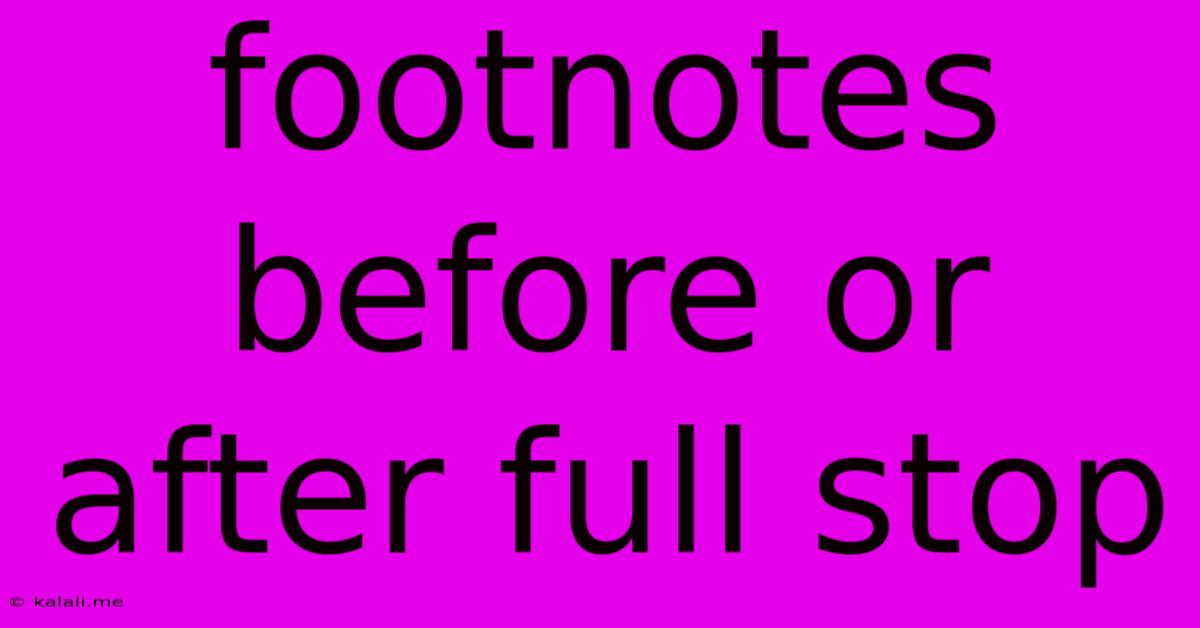Footnotes Before Or After Full Stop
Kalali
May 20, 2025 · 3 min read

Table of Contents
Footnotes: Before or After the Full Stop? A Punctuation Conundrum
The placement of footnotes—those helpful little notes at the bottom of the page—is a surprisingly contentious topic. Should the footnote marker come before or after the final punctuation mark in a sentence? The answer, as with many stylistic choices, isn't universally agreed upon, but understanding the different styles will help you make a consistent and informed decision for your writing. This article will explore both styles, offering guidance to help you navigate this punctuation puzzle.
The Traditional Style: Footnote Marker After the Punctuation
For many years, the prevailing style guide dictated that the footnote marker (a superscript number) should appear after the full stop (or other terminal punctuation) and be placed outside the closing punctuation. This is the style preferred by many academic institutions and traditional publishing houses.
Consider this example:
"The quick brown fox jumps over the lazy dog.¹"
In this example, the footnote marker '¹' is placed after the full stop. This method maintains a clear separation between the main text and the supplementary information. It preserves the integrity of the sentence's punctuation and follows a well-established convention. This approach offers clarity and emphasizes the sentence structure. It’s a style that prioritizes traditional grammar rules and is often considered more formal. It's a consistent approach that aids readability, especially in academic papers or scholarly articles.
The Modern and More Concise Style: Footnote Marker Before the Punctuation
Increasingly, a more concise style is gaining popularity, especially in online publishing and less formal writing. This style places the footnote marker before the final punctuation mark.
Using the same example:
"The quick brown fox jumps over the lazy dog.¹"
Notice the subtle difference? The footnote marker precedes the full stop. While seemingly minor, this adjustment can contribute to a slightly more streamlined and modern aesthetic. This method is often viewed as less disruptive to the flow of reading. Some argue it’s more visually appealing and less cluttered, particularly in text with numerous footnotes. However, this approach might be considered less formal in some settings.
Which Style Should You Choose?
The best approach depends largely on your intended audience and the style guide you're following.
-
Academic Papers and Formal Publications: Generally, the traditional style (footnote marker after the punctuation) remains the safest and most widely accepted choice. Consulting specific style guides (like the Chicago Manual of Style or the MLA Handbook) is crucial for consistency.
-
Online Publications and Less Formal Writing: The modern style (footnote marker before the punctuation) is becoming increasingly common, particularly in blog posts, articles for online magazines, and other less formal contexts.
-
Consistency is Key: Regardless of your choice, maintain consistency throughout your document. Switching between styles mid-article will create a jarring effect and detract from the overall professionalism of your writing.
Ultimately, the key to successful footnote placement is consistency and clarity. Choose a style, stick to it, and ensure your footnotes enhance the reader's understanding of your text without disrupting the flow. Consider your audience and the context of your writing before making a decision. Remember, clear communication is paramount, and consistent punctuation contributes significantly to that goal.
Latest Posts
Latest Posts
-
How To Disarm A House Alarm Without The Code
May 21, 2025
-
How Do You Say It Was In French
May 21, 2025
-
What Are Sills On A Car
May 21, 2025
-
Can You Lay Vinyl Over Vinyl
May 21, 2025
-
Fallout 4 How To Get Out Of Power Armor
May 21, 2025
Related Post
Thank you for visiting our website which covers about Footnotes Before Or After Full Stop . We hope the information provided has been useful to you. Feel free to contact us if you have any questions or need further assistance. See you next time and don't miss to bookmark.